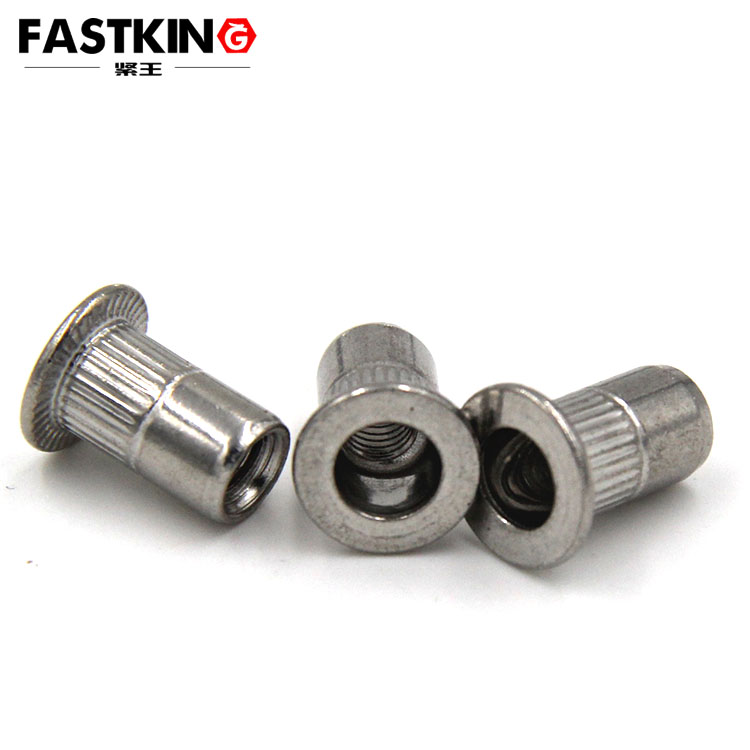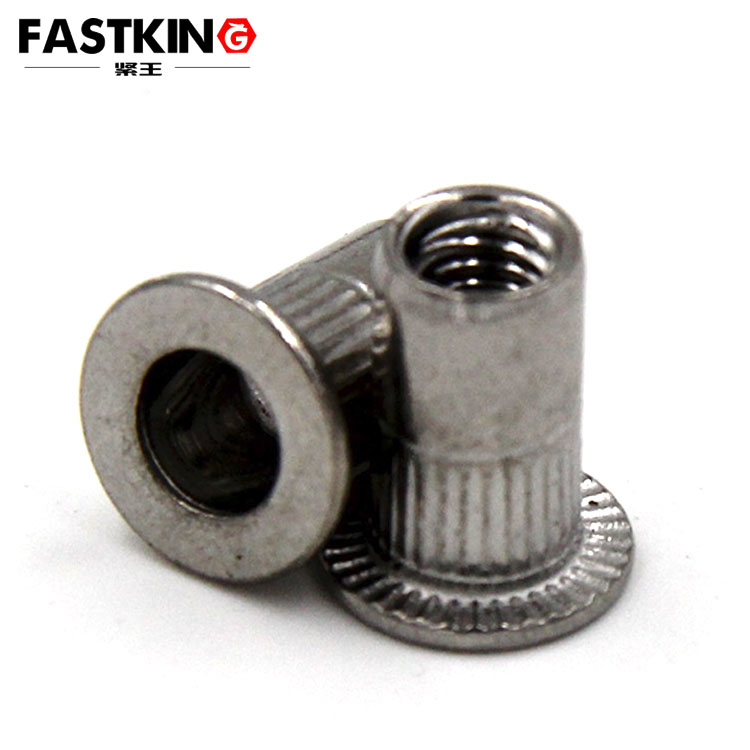The Principle and Applications of Flat Head Ribbed Rivet Nuts
Introduction
Flat head ribbed rivet nuts are a common type of fastener widely used in various mechanical equipment and structures. Their unique design and efficient installation method make them highly favored in the industrial sector. This article will provide a detailed introduction to the working principle and application fields of flat head ribbed rivet nuts.
I. Structure and Characteristics of Flat Head Ribbed Rivet Nuts
Structure
Flat head ribbed rivet nuts mainly consist of the following parts:
-
Nut Body: Typically cylindrical in shape, with internal threads for mating with bolts.
-
Ribs: Located on the outer surface of the nut, arranged longitudinally to increase friction and prevent the nut from rotating during installation.
-
Flat Head: One end of the nut is designed with a flat head, allowing it to sit flush with the workpiece surface after installation, ensuring aesthetics and not interfering with subsequent operations.
Characteristics
-
High Friction: The ribbed design increases friction between the nut and the workpiece, preventing rotation during installation.
-
Easy Installation: The flat head design ensures the nut sits flush with the workpiece surface, facilitating subsequent operations.
-
High Strength: Made from high-strength materials, ensuring the nut maintains a secure connection even under high-pressure conditions.
II. Working Principle of Flat Head Ribbed Rivet Nuts
Installation Process
The installation process of flat head ribbed rivet nuts mainly includes the following steps:
Pre-Drilling: Drill a hole in the workpiece that matches the outer diameter of the nut.
-
Inserting the Nut: Insert the flat head ribbed rivet nut into the pre-drilled hole, ensuring the ribs are in contact with the workpiece surface.
-
Riveting: Use a specialized riveting tool to apply pressure, pressing the ribs into the workpiece surface to form a secure connection.
-
Completion: After installation, the nut sits flush with the workpiece surface, ensuring both aesthetics and functionality.
Working Principle
The working principle of flat head ribbed rivet nuts primarily relies on the friction between the ribs and the workpiece surface. During installation, the ribs are pressed into the workpiece surface, creating a tight contact that prevents the nut from rotating or loosening during subsequent use. Additionally, the internal threads of the nut mate with the bolt, forming a stable connection that ensures the overall structural stability.
III. Application Fields of Flat Head Ribbed Rivet Nuts
Automotive Manufacturing
In the automotive manufacturing industry, flat head ribbed rivet nuts are widely used for connecting body structures. Their high strength and ease of installation make them an essential fastener on automotive production lines. For example, in doors, hoods, and trunk lids, flat head ribbed rivet nuts provide secure connections, ensuring the safety and stability of the vehicle during operation.
Aerospace
In the aerospace industry, flat head ribbed rivet nuts are used for fastening aircraft fuselages and engines. Due to the extremely high requirements for fasteners in aerospace equipment, the high strength and corrosion resistance of flat head ribbed rivet nuts make them an ideal choice. For instance, in the connection points of aircraft wings and fuselages, flat head ribbed rivet nuts can withstand high-intensity vibrations and pressures, ensuring flight safety.
Electronic Devices
In the electronic device manufacturing industry, flat head ribbed rivet nuts are used to secure circuit boards and other precision components. Their flat head design ensures that after installation, they sit flush with the workpiece surface, not affecting the internal structure or appearance of the device. For example, in securing computer motherboards and power supply units, flat head ribbed rivet nuts provide stable connections, ensuring the normal operation of the equipment.
Construction Industry
In the construction industry, flat head ribbed rivet nuts are used for connecting steel and concrete structures. Their high strength and corrosion resistance make them an important fastener in the construction field. For example, in the steel structures of bridges and high-rise buildings, flat head ribbed rivet nuts provide secure connections, ensuring the safety and durability of the structures.
IV. Conclusion
Flat head ribbed rivet nuts, as an efficient and reliable fastener, play a significant role in multiple fields. Their unique design and efficient installation method make them an essential tool in industrial manufacturing and construction. By understanding their working principle and application fields, we can better utilize this fastener to improve production efficiency and product quality.
